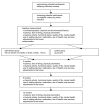The effect of Tai Chi Chuan in reducing falls among elderly people: design of a randomized clinical trial in the Netherlands [ISRCTN98840266]
- PMID: 16573825
- PMCID: PMC1513573
- DOI: 10.1186/1471-2318-6-6
The effect of Tai Chi Chuan in reducing falls among elderly people: design of a randomized clinical trial in the Netherlands [ISRCTN98840266]
Abstract
Background: Falls are a significant public health problem. Thirty to fifty percent of the elderly of 65 years and older fall each year. Falls are the most common type of accident in this age group and can result in fractures and subsequent disabilities, increased fear of falling, social isolation, decreased mobility, and even an increased mortality. Several forms of exercise have been associated with a reduced risk of falling and with a wide range of physiological as well as psychosocial health benefits. Tai Chi Chuan seems to be the most promising form of exercise in the elderly, but the evidence is still controversial. In this article the design of a randomized clinical trial is presented. The trial evaluates the effect of Tai Chi Chuan on fall prevention and physical and psychological function in older adults.
Methods/design: 270 people of seventy years and older living at home will be identified in the files of the participating general practitioners. People will be asked to participate when meeting the following inclusion criteria: have experienced a fall in the preceding year or suffer from two of the following risk factors: disturbed balance, mobility problems, dizziness, or the use of benzodiazepines or diuretics. People will be randomly allocated to either the Tai Chi Chuan group (13 weeks, twice a week) or the no treatment control group. The primary outcome measure is the number of new falls, measured with a diary. The secondary outcome measures are balance, fear of falling, blood pressure, heart rate, lung function parameters, physical activity, functional status, quality of life, mental health, use of walking devices, medication, use of health care services, adjustments to the house, severity of fall incidents and subsequent injuries. Process parameters will be measured to evaluate the Tai Chi Chuan intervention. A cost-effectiveness analysis will be carried out alongside the evaluation of the clinical results. Follow-up measurements will be collected at 3, 6 and 12 months after randomization.
Discussion: As far as we know this is the first trial in Europe considering Tai Chi Chuan and fall prevention. This project will answer a pragmatic research question regarding the efficacy of Tai Chi Chuan regarding fall reduction.
References
-
- Brummel-Smith K, Kottke FJ, Williams GO. Uw bejaarde patiënt is gevallen. Patient Care. 1989. pp. 15–31.
-
- Gillespie LD, Gillespie WJ, Robertson MC, Lamb SE, Cumming RG, Rowe BH. Interventions for preventing falls in elderly people. Cochrane Database Syst Rev. 2003. - PubMed
-
- Campbell AJ, Borrie MJ, Spears GF, Jackson SL, Brown JS, Fitzgerald JL. Circumstances and consequences of falls experienced by a community population 70 years and over during a prospective study. Age Ageing. 1990;19:136–141. - PubMed
-
- Soomers-Turlings JMSJG, Crebolder HFJM, Beusmans GHMI, Bal RM. Het vallen van ouderen - Een exploratieve studie in de huisartspraktijk. Huisarts en Wetenschap. 1992;35:57–60.
-
- Blake AJ, Morgan K, Bendall MJ, Dallosso H, Ebrahim SB, Arie TH, Fentem PH, Bassey EJ. Falls by elderly people at home: prevalence and associated factors. Age Ageing. 1988;17:365–372. - PubMed
Publication types
MeSH terms
Associated data
LinkOut - more resources
Full Text Sources
Medical
Research Materials


